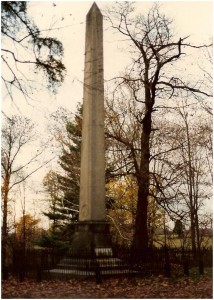Indiana at 200 (16): Frontier Violence at Pigeon Roost
by Andrea Neal
On Sept. 3, 1812, a Native American war party killed more than 20 settlers living in a wooded outpost near present-day Scottsburg. Motivated by bounties offered by the British, the perpetrators scalped women and children, torched their log cabins and left the village in ashes.
The Massacre at Pigeon Roost is the most notorious example of frontier violence in Indiana history. To this day, it is shrouded in mystery. As the Indiana Historical Bureau notes, “There are many accounts of this tragedy in which the actions and specific numbers killed vary.”
This much is clear: The massacre left settlers on guard as the War of 1812 raged in their own backyard.
The United States had declared war on Great Britain in June 1812 in response to British harassment of American ships, occupation of forts and alleged incitement of Native Americans in the Old Northwest, including Indiana. Indians generally sided with the British, and they were encouraged after the fall of Detroit to conduct raids on pioneer settlements throughout the Midwest.
Pigeon Roost was one such place, named after passenger pigeons that used the area as a roosting site where they fertilized the soil and provided a plentiful poultry supply. The village was founded in 1809 by Revolutionary War soldier William E. Collings, who had moved north from Kentucky with family and friends.
Early histories of the episode seem culturally biased if not inflammatory — by 2014 sensibilities. Lizzie Coleman’s 1904 “History of the Pigeon Roost Massacre” referred to “bands of savage redskins.” George Cottman’s 1915 “Centennial History and Handbook of Indiana” described the massacre as “the most diabolical event in our Indian history.”
Some believe Pigeon Roost was a random but easy target because most men were away in the military service of General William Henry Harrison, which left remaining residents vulnerable to attack. Some say Pigeon Roost was specifically chosen by the war party of mostly Shawnees.
A 1909 “History of Clark County” by Lewis Baird claimed bad blood existed between the Collings family and local Indians because “the Collins {sic} boys had stolen a fawn from the Indians and refused to give it up.” The elder Collings was home at the time of the massacre and provided the only armed resistance to the Native Americans, killing at least two of them.
In 1888, the Indiana Historical Society published an account of the incident by Judge Isaac Naylor, a member of the Indiana Territory militia, who had arrived at the site the following day.
“Oh, what a mournful scene of desolation, carnage and death met our vision as we beheld the smoking ruins of log cabins and the mangled bodies of men and women and children,” Naylor wrote.
A monument commemorating the victims was dedicated in 1904 and became a state historic site in 1929.
Following the massacre, settlers in the areas of Clark, Scott, Jefferson, Harrison and Knox counties lived in a state of fear until the Treaty of Ghent ended war with England on December 24, 1814. For frontier men and women, the treaty symbolized the defeat of the Indians and the barrier they posed to westward expansion.
djv
Directions to Pigeon Roost State Historic Site: From I-65, take exit 29A toward Scottsburg and go east to U.S. 31. Drive south to approximately five miles south of Scottsburg. GPS address is Underwood, Ind., 47177.


Comments...